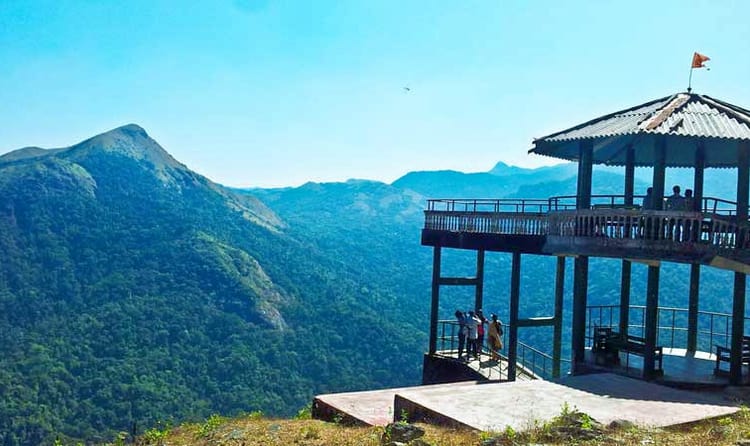I wake up to a shower of birdcalls. From the window on my left, I catch a long, warbling melody followed by a series of high-pitched whoops. The birds scuttle around with purpose, feeding little ones, pecking affectionately at their mates, pausing every now and then to listen to the whispers of the forest, their tails swinging like pendulums and their heads cocked at a gentle degree of politeness. I can’t identify the red-breasted singer, the owl-looking wise one perched on a tree-top, or the little sparrow-like bird with the yellow-flecked wings, but I bask in their songs. From my balcony overlooking the rain-washed forest, everything sparkles anew. I waddle back to bed, snuggle under my blanket, and fall asleep, secure in the knowledge that my picture-perfect forest view will still be here an hour later—with a cup of steaming filter coffee.
Located between Coorg and Chikmagalur—Karnataka’s more famous weekend getaways—Sakleshpur is permanently swathed in robes of emerald and jade. Its slopes are filled with Arabica coffee plantations, gorgeous waterfalls, and trekking routes to suit all abilities. For those who like to spend vacations reading, dozing off, and living the life of a bean bag, there are intimate homestays. Others who prefer more invigorating weekends can spend their time trekking the Western Ghats, snooping for orchids, colourful frogs, and the numerous species of birds that live here.
Sakleshpur’s rolling hills and gentle bird symphonies are the perfect antidote to the city’s thumping, traffic-filled bass line.
Ancient Ruins
The ruins of the Holy Rosary Church in the Gorur Dam at Shettyhalli (62 km/1 hour from Sakleshpur) have a haunting beauty about them, especially after the monsoon. In the summer, the ruins stand on a scraggly hillock by the River Hemavathi. After the rains, however, the waters of the Gorur Dam swell, submerging half the structure. Built by French missionaries in the 1860s, the church was abandoned when the reservoir for the Hemavathi was built in 1972. Much of the gothic structure, like the ceilings and stained-glass windows, is gone, but the pointed arches, spires, and the sanctuary remain. In the monsoon, fishermen offer coracle rides to the church, rowing their boats under the arches, and past the sculpted columns that now have a roster of names scratched upon them. If you’re driving, visit the church en route to Sakleshpur.
Manjarabad Fort (6 km/10 minutes) looks far more impressive in the aerial pictures taped to chai shops near the structure—its outer walls form a perfectly symmetrical eight-pointed star. It is worth a visit despite its weathered condition. Constructed by Tipu Sultan in 1792, the fort has scalloped archways, an unusual, cross-shaped well in the centre, and an underground tunnel that supposedly leads to Srirangapatnam, 114 kilometres away. Around the central courtyard are chambers, now covered in moss, that were once used as stables and warehouses for grain and arsenal. In the 17th century, Tipu Sultan’s soldiers used the watchtowers to keep an eye out for British soldiers approaching from Mangalore. Today, they give visitors a clear view of the Western Ghats that stretch as far as the eye can see.
Plantation Walks
Sakleshpur is perfect for hours of pondering or aimless wandering. Most resorts are located on sprawling coffee plantations. Owners of homestays like Mugilu are happy to accompany guests on long walks, pointing out Arabica and Robusta coffee varieties, cinnamon trees, orange thickets, and rolling meadows that are a favourite with Kannadiga movie producers. Every trip, however small or large, is rewarded with fresh, frothy filter coffee and snacks that range from piping hot bhajiyas and vegetable upma, to biscuits and Mangalore buns (baturas made with banana batter), which are a local favourite.
Adrenaline Boost
The Western Ghats are filled with hiking trails. Some weave their way through the thick of the forest, filled with gurgling streams and intimate waterfalls that attract a bevy of colourful bugs and frogs (watch out for leeches though). Others ascend quickly past the forest of trees to the smooth grass-topped peaks. These hikes are relatively tough, but the feeling of the wind whipping through your hair and the clouds at your feet is well worth the effort. Ask your hosts to give you a thermos full of filter coffee to take with you—it’s a cuppa you’ll never forget.
Market Watch
Sakleshpur has one crowded street, filled with stores. B.M. Road is about a kilometre long, clustered with ATMs, petrol pumps, and stores selling spices, coffee, and flashy clothing. At Karnataka Coffee House, you can examine pale, just-picked coffee beans, see how dark they become after roasting, and take home robust chicory-coffee blends. Spice marts along the stretch sell bottles of thick, fresh honey, and packets of black, green and white cardamom, cinnamon, mace, and vanilla at throwaway prices.




3 Comments
Your article on the five reasons to visit beautiful places like Sakleshpur was a great read! As someone who loves exploring new destinations and experiencing their unique charm, I found your reasons to be very compelling.
Your article on the five reasons to visit beautiful places like Sakleshpur was very informative and inspiring. I appreciate the focus on natural beauty, outdoor activities, and cultural significance.
Thank you for sharing such a wonderful information. Your blog was a great reminder of the beauty and diversity that exists in India